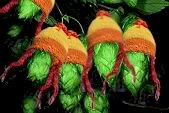Tue Feb 28, 2006 1:23 pm
I'm helping a local microbrewery put together a recipe for a dopplebock.
May I recommend trying to nail Schneiderweisse Aventinus Eisbock? It is the BEST dopplebock I've ever had, and could very well be the reason I started brewing.
I've not tried either of the recipes below, but you might give them a shot. I'm a bit skeptical inasmuch as I thought dopplebocks were lagers fermented warm, but I'm not sure.
Augustus Weizenbock
By TheBeerOrg
Aventinus is a good beer, and I’ve tried several times to clone it. I keep getting closer, but you need a long boil and high fermentation temperatures. Needs about 2 months to get really tasty.
8 lbs Wheat Malt
4 lbs Belgian Pilsner Malt
3 lbs Munich
4 oz Melanoidin
2.5 oz Caramel Wheat
2 oz Hallertau (bittering)
Wyeast 3068
1. Prepare 1 liter starter 3 days in advance.
2. On the day before the brew, feed the starter an additional quart of 1.040 wort, and transfer to a gallon growler.
3. Heat 16 quarts of strike water to 170F.
4. Mash at 154F, adjusting temps for 60 minutes.
5. Recirculate and pour first running into kettle.
6. Sparge with additional 16 quarts, steep for 10 minutes.
7. Recirculate until clear, pour into kettle.
8. Add 1oz of Hallertau.
9. Boil for an hour.
10. Add 1oz of Hallertau.
11. Boil for an hour.
12. Cool to 78F and pitch yeast.
Aventinus Weizenbock
by Mikoli Weaver
(5 gallons, all-grain)
Ingredients:
7.25 lbs. wheat malt
6 lbs. Munich two-row
0.3 lb. chocolate malt
1.25 oz. Hallertauer hops (3.7% alpha acid): 1 oz. for 90 min., 0.25 oz. at end of boil
Wyeast 2206 (Bavarian lager) or 3333 (German wheat)
2/3 cup corn sugar for priming
Step by Step:
Mash grains in 4.25 gal. water in a single infusion at 152° F for 60 min. Sparge with 170° F water to collect 5.5 gal.
Total boil is 90 min. At start of boil, add 1 oz. Hallertauer hops. At end of boil add 0.25 oz. Hallertauer hops. Chill to 45° F and pitch yeast in a starter.
Ferment at 45° F for three days. Raise to 50° F for three days. Raise to 55°. Rack into secondary when gravity reaches less than 1.020. Cool to 40° F and ferment to 1.008 (about three more days). Age at 40° F until clear (seven to
14 days). Bottle and prime. Condition in the bottle as long as desired (30 to 60 days).
*Note: To employ a step mash, the real Aventius employs a rest at 128° F and is stepped up to 152° F with hot water.
"If you have a scale thats good for weighing cocaine, its good enough for hops."
Pope Jamil


